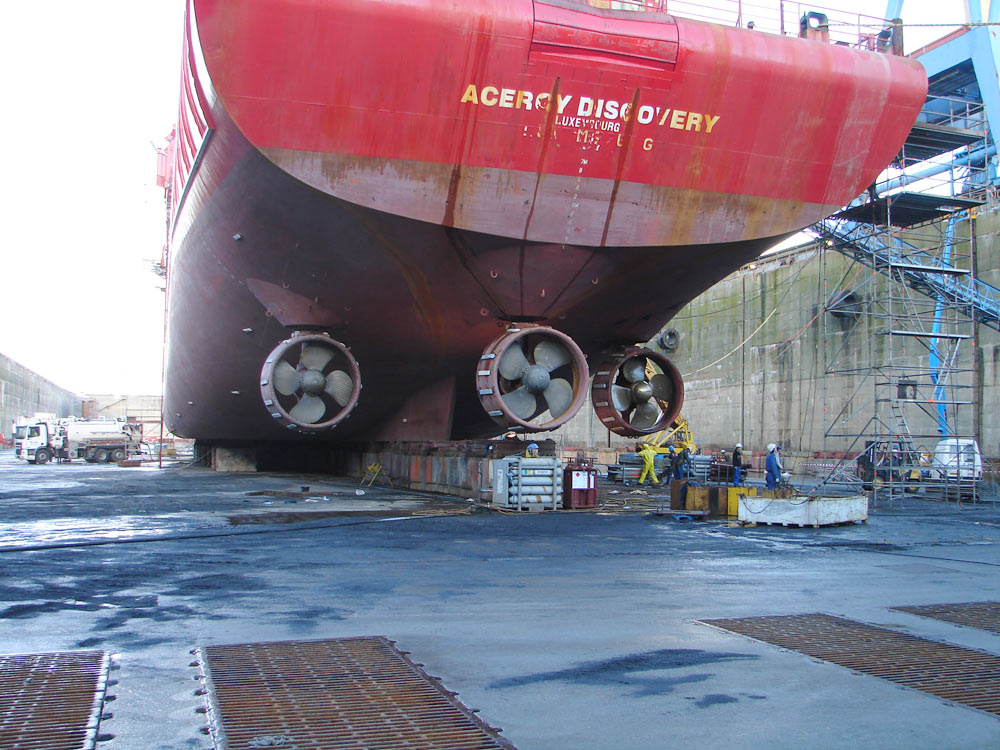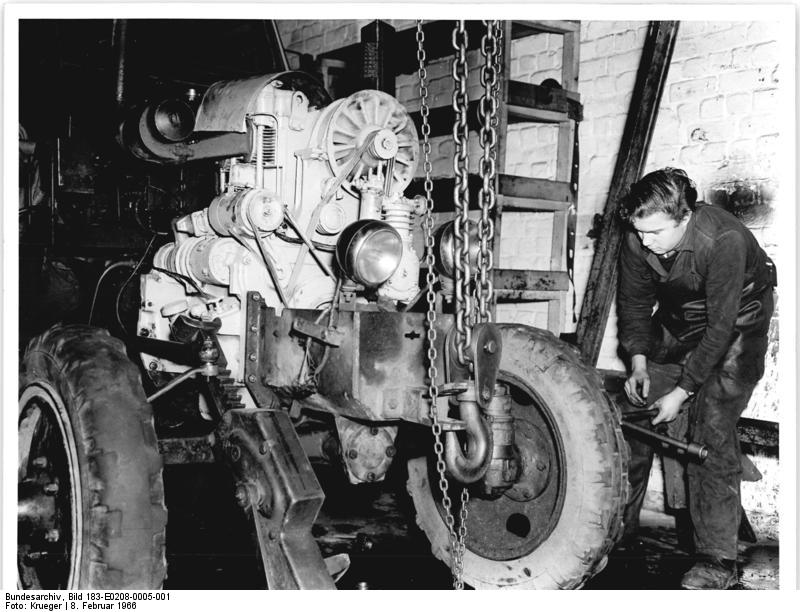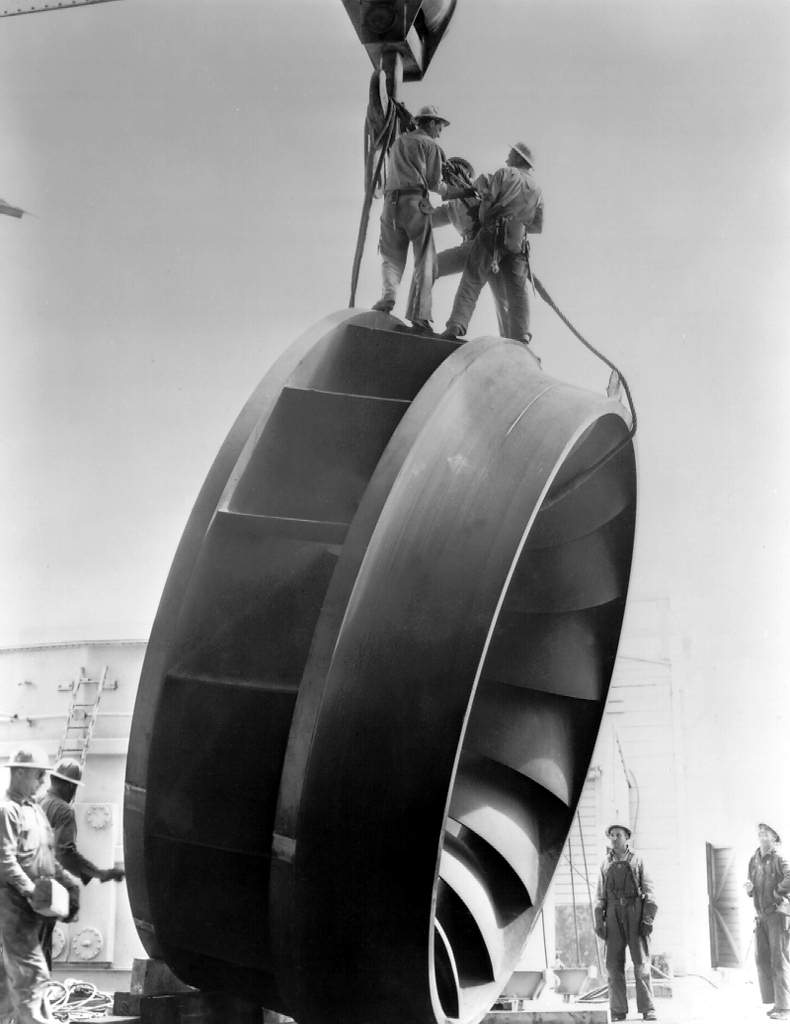|
Thruster (marine )
A marine thruster is a device for producing directed hydrodynamic thrust mounted on a marine vehicle, primarily for maneuvering or propulsion. There are a variety of different types of marine thrusters and each of them plays a role in the maritime industry. Marine thrusters come in many different shapes and sizes, for example screw propellers, Voith-Schneider propellers, waterjets, ducted propellers, tunnel bow thrusters, and stern thrusters, azimuth thrusters, rim-driven thrusters, ROV and submersible drive units. A marine thruster consists of a propeller or impeller which may be encased in some kind of tunnel or ducting that directs the flow of water to produce a resultant force intended to obtain movement in the desired direction or resist forces which would cause unwanted movement. The two subcategories of marine thrusters are for propulsion and maneuvering, the maneuvering thruster typically in the form of bow or stern thrusters and propulsion thrusters ranging from Az ... [...More Info...] [...Related Items...] OR: [Wikipedia] [Google] [Baidu] |
Acergy Discovery In Drydock 5
Acergy S.A. was an international offshore seabed to surface engineering and construction company previously known as Stolt Offshore and Stolt Comex Seaway and was part of the Stolt-Nielsen Group until 2005. The company was registered in Luxembourg and had its headquarters in London in the United Kingdom as well as offices in Stavanger, Norway; Aberdeen, United Kingdom; Suresnes, France; Houston, United States; Rio de Janeiro, Brazil; Perth, Australia; St. John's, Canada and Singapore. The company was listed on the Oslo Stock Exchange and NASDAQ. In 2011 the firm merged with Cayman Islands-based Subsea 7, Inc. to create Subsea 7 S.A. History The company started as the Haugesund based Stolt Nielsen Seaway and offered divers for the exploration of the North Sea in 1970. The company was part of the Stolt-Nielsen Group. In 1989 the company expanded to Aberdeen and in 1992 the company acquired the French diving company Comex Services. In 1997 the company won its first ultra-deepwater ... [...More Info...] [...Related Items...] OR: [Wikipedia] [Google] [Baidu] |
Propeller
A propeller (colloquially often called a screw if on a ship or an airscrew if on an aircraft) is a device with a rotating hub and radiating blades that are set at a pitch to form a helical spiral which, when rotated, exerts linear thrust upon a working fluid such as water or air. Propellers are used to pump fluid through a pipe or duct, or to create thrust to propel a boat through water or an aircraft through air. The blades are specially shaped so that their rotational motion through the fluid causes a pressure difference between the two surfaces of the blade by Bernoulli's principle which exerts force on the fluid. Most marine propellers are screw propellers with helical blades rotating on a propeller shaft (ship), propeller shaft with an approximately horizontal axis. History Early developments The principle employed in using a screw propeller is derived from sculling. In sculling, a single blade is moved through an arc, from side to side taking care to keep presenting the ... [...More Info...] [...Related Items...] OR: [Wikipedia] [Google] [Baidu] |
Ship
A ship is a large watercraft that travels the world's oceans and other sufficiently deep waterways, carrying cargo or passengers, or in support of specialized missions, such as defense, research, and fishing. Ships are generally distinguished from boats, based on size, shape, load capacity, and purpose. Ships have supported exploration, trade, warfare, migration, colonization, and science. After the 15th century, new crops that had come from and to the Americas via the European seafarers significantly contributed to world population growth. Ship transport is responsible for the largest portion of world commerce. The word ''ship'' has meant, depending on the era and the context, either just a large vessel or specifically a ship-rigged sailing ship with three or more masts, each of which is square-rigged. As of 2016, there were more than 49,000 merchant ships, totaling almost 1.8 billion dead weight tons. Of these 28% were oil tankers, 43% were bulk carriers, and ... [...More Info...] [...Related Items...] OR: [Wikipedia] [Google] [Baidu] |
Dock (maritime)
A dock (from Dutch ''dok'') is the area of water between or next to one or a group of human-made structures that are involved in the handling of boats or ships (usually on or near a shore) or such structures themselves. The exact meaning varies among different variants of the English language. "Dock" may also refer to a dockyard (also known as a shipyard) where the loading, unloading, building, or repairing of ships occurs. History The earliest known docks were those discovered in Wadi al-Jarf, an ancient Egyptian harbor, of Pharaoh Khufu, dating from c.2500 BC located on the Red Sea coast. Archaeologists also discovered anchors and storage jars near the site. A dock from Lothal in India dates from 2400 BC and was located away from the main current to avoid deposition of silt. Modern oceanographers have observed that the ancient Harappans must have possessed great knowledge relating to tides in order to build such a dock on the ever-shifting course of the Sabarmati, a ... [...More Info...] [...Related Items...] OR: [Wikipedia] [Google] [Baidu] |
Repairing A Bow Thruster
The technical meaning of maintenance involves functional checks, servicing, repairing or replacing of necessary devices, equipment, machinery, building infrastructure, and supporting utilities in industrial, business, and residential installations. Over time, this has come to include multiple wordings that describe various cost-effective practices to keep equipment operational; these activities occur either before or after a failure. Definitions Maintenance functions can defined as maintenance, repair and overhaul (MRO), and MRO is also used for maintenance, repair and operations. Over time, the terminology of maintenance and MRO has begun to become standardized. The United States Department of Defense uses the following definitions:Federal Standard 1037C and from MIL-STD-188 and from the Department of Defense Dictionary of Military and Associated Terms * Any activity—such as tests, measurements, replacements, adjustments, and repairs—intended to retain or restore a func ... [...More Info...] [...Related Items...] OR: [Wikipedia] [Google] [Baidu] |
Rim-driven Thruster
The rim-driven thruster, also known as rim-driven propulsor/propeller (or RDP) is a novel type of electric propulsion unit for ships. The concept was proposed by Kort around 1940, but only became commercially practical in the early 21st century due to advances in DC motor controller technology. As of 2017, commercial models of between 500 kW and 3MW are available from manufacturers such as Rolls-Royce, Schottel, Brunvoll, Voith, Van der Velden, etc. Principle The rim-driven thruster is a marine propeller that does not use a central hub for transmission of the driving torque. Conventional hubcentric propellers typically use a shaft driven by a turbine, a diesel engine or an electric motor. The more recent podded drives consist of a propeller driven by a conventional electric motor into an azimuthable gondola under water, but they still incorporate a traditional hubcentric propeller. The blades of the rim-driven thruster, by contrast, are mounted on an outer ring rather ... [...More Info...] [...Related Items...] OR: [Wikipedia] [Google] [Baidu] |
Azimuth Thruster
An azimuth thruster is a configuration of marine propellers placed in pods that can be rotated to any horizontal angle (azimuth), making a rudder unnecessary. These give ships better maneuverability than a fixed propeller and rudder system. Types of azimuth thrusters There are two major variants, based on the location of the motor: # Mechanical transmission, which connects a motor inside the ship to the outboard unit by gearing. The motor may be diesel or diesel-electric. Depending on the shaft arrangement, mechanical azimuth thrusters are divided into L-drive and Z-drive. An L-drive thruster has a vertical input shaft and a horizontal output shaft with one right-angle gear. A Z-drive thruster has a horizontal input shaft, a vertical shaft in the rotating column and a horizontal output shaft, with two right-angle gears. # Electrical transmission, more commonly called pods, where an electric motor is fitted in the pod itself, connected directly to the propeller without ge ... [...More Info...] [...Related Items...] OR: [Wikipedia] [Google] [Baidu] |
Manoeuvring Thruster
Manoeuvering thruster (bow thruster or stern thruster) is a transversal propulsion device built into, or mounted to, either the bow or stern, of a ship or boat to make it more manoeuvrable. Bow thrusters make docking easier, since they allow the captain to turn the vessel to port or starboard side, without using the main propulsion mechanism which requires some forward motion for turning; The effectiveness of a thruster is curtailed by any forward motion due to the Coandă effect. A stern thruster is of the same principle, fitted at the stern. Large ships might have multiple bow thrusters and stern thrusters. Tunnel thrusters Large vessels usually have one or more tunnel thrusters built into the bow, below the waterline. An impeller in the tunnel can create thrust in either direction that makes the ship turn. Most tunnel thrusters are driven by electric motors, but some are hydraulically powered. These bow thrusters, also known as tunnel thrusters, may allow the ship to d ... [...More Info...] [...Related Items...] OR: [Wikipedia] [Google] [Baidu] |
Propulsion
Propulsion is the generation of force by any combination of pushing or pulling to modify the translational motion of an object, which is typically a rigid body (or an articulated rigid body) but may also concern a fluid. The term is derived from two Latin words: ''wikt:pro, pro'', meaning'' before'' or ''forward''; and ''wikt:pellere, pellere'', meaning ''to drive''. A propulsion system consists of a source of mechanical power, and a ''propulsor'' (means of converting this power into propulsive force). Plucking a guitar string to induce a vibration, vibratory translation is technically a form of propulsion of the guitar string; this is not commonly depicted in this vocabulary, even though human muscles are considered to propel the fingertips. The motion of an object moving through a gravitational field is affected by the field, and within some frames of reference physicists speak of the gravitational field generating a force upon the object, but for general relativity, deep the ... [...More Info...] [...Related Items...] OR: [Wikipedia] [Google] [Baidu] |
Impeller
An impeller or impellor is a rotor used to increase the pressure and flow of a fluid. It is the opposite of a turbine, which extracts energy from, and reduces the pressure of, a flowing fluid. In pumps An impeller is a rotating component of a centrifugal pump that accelerates fluid outward from the center of rotation, thus transferring energy from the motor that drives the pump to the fluid being pumped. The velocity achieved by the impeller transfers into pressure when the outward movement of the fluid is confined by the pump casing. An impeller is usually a short cylinder with an open inlet (called an eye) to accept incoming fluid, vanes to push the fluid radially, and a splined, keyed, or threaded bore to accept a drive shaft. It can be cheaper to cast an impeller and its spindle as one piece, rather than separately. This combination is sometimes referred to simply as the "rotor." Types Open impellers An open impeller has a hub with attached vanes and is mounted ... [...More Info...] [...Related Items...] OR: [Wikipedia] [Google] [Baidu] |
Submersible
A submersible is a small watercraft designed to operate underwater. The term "submersible" is often used to differentiate from other underwater vessels known as submarines, in that a submarine is a fully self-sufficient craft, capable of independent cruising with its own power supply and air renewal system, whereas a submersible is usually supported by a nearby ship, surface vessel, very large floating structure, platform, shore team or sometimes a larger submarine. In common usage by the general public, however, the word "submarine" may be used to describe a craft that is by the technical definition actually a submersible. There are many types of submersibles, including both crewed and uncrewed craft, otherwise known as remotely operated vehicles (ROVs) or unmanned underwater vehicles (UUVs). Submersibles have many uses worldwide, such as oceanography, underwater archaeology, ocean exploration, adventure, equipment maintenance and recovery, and underwater videography. Histo ... [...More Info...] [...Related Items...] OR: [Wikipedia] [Google] [Baidu] |



